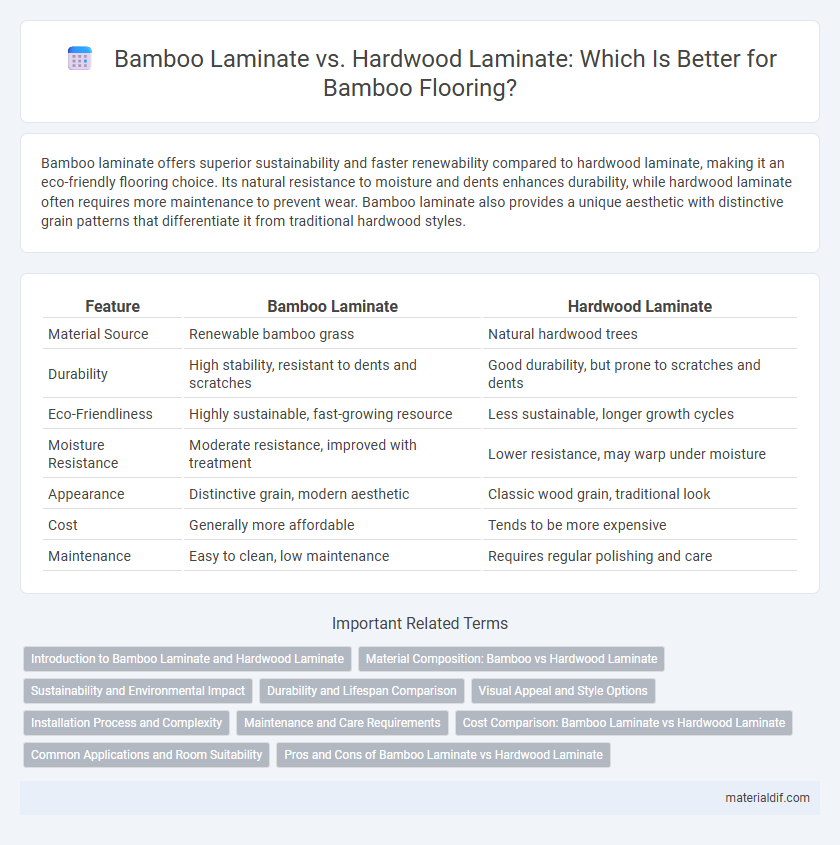Bamboo laminate offers superior sustainability and faster renewability compared to hardwood laminate, making it an eco-friendly flooring choice. Its natural resistance to moisture and dents enhances durability, while hardwood laminate often requires more maintenance to prevent wear. Bamboo laminate also provides a unique aesthetic with distinctive grain patterns that differentiate it from traditional hardwood styles.
Table of Comparison
| Feature | Bamboo Laminate | Hardwood Laminate |
|---|---|---|
| Material Source | Renewable bamboo grass | Natural hardwood trees |
| Durability | High stability, resistant to dents and scratches | Good durability, but prone to scratches and dents |
| Eco-Friendliness | Highly sustainable, fast-growing resource | Less sustainable, longer growth cycles |
| Moisture Resistance | Moderate resistance, improved with treatment | Lower resistance, may warp under moisture |
| Appearance | Distinctive grain, modern aesthetic | Classic wood grain, traditional look |
| Cost | Generally more affordable | Tends to be more expensive |
| Maintenance | Easy to clean, low maintenance | Requires regular polishing and care |
Introduction to Bamboo Laminate and Hardwood Laminate
Bamboo laminate flooring is crafted from fast-growing bamboo grass, offering eco-friendly durability and a unique grain pattern that distinguishes it from traditional wood laminates. Hardwood laminate mimics the appearance of various hardwood species through photographic layers over fiberboard, delivering cost-effective aesthetics but typically less moisture resistance compared to bamboo. Both materials provide versatile flooring solutions, but bamboo laminate stands out for its sustainability and natural resilience.
Material Composition: Bamboo vs Hardwood Laminate
Bamboo laminate consists primarily of fast-growing bamboo fibers compressed into dense, durable planks, offering eco-friendly and sustainable material composition. Hardwood laminate uses layers of plywood or high-density fiberboard topped with a photographic layer replicating natural hardwood grains. Bamboo laminate typically provides higher moisture resistance and hardness compared to traditional hardwood laminate, enhancing durability in various environments.
Sustainability and Environmental Impact
Bamboo laminate offers superior sustainability compared to hardwood laminate due to its rapid growth rate, reaching maturity in 3 to 5 years, which allows for quicker replenishment and less deforestation. Bamboo's environmental impact is lower as it requires minimal pesticides and fertilizers, while hardwood laminate often involves slower-growing trees, leading to habitat loss and higher carbon emissions from logging and transportation. Choosing bamboo laminate supports renewable resource use and reduces the carbon footprint associated with flooring materials.
Durability and Lifespan Comparison
Bamboo laminate offers superior durability compared to hardwood laminate due to its dense fiber structure and natural resistance to moisture and wear. Bamboo flooring typically has a lifespan ranging from 20 to 25 years, exceeding many hardwood laminates that last about 15 to 20 years under similar conditions. The increased hardness rating of bamboo products, often measured by the Janka hardness scale, contributes to its resilience against scratches and dents, making it a long-lasting flooring option.
Visual Appeal and Style Options
Bamboo laminate offers a unique, natural grain pattern that creates a modern, eco-friendly aesthetic, while hardwood laminate provides a classic, rich look with a wide variety of wood species and finishes. The versatility of hardwood laminate allows for diverse styles ranging from rustic to contemporary, whereas bamboo laminate tends to emphasize a sleek, minimalist design. Both materials enhance visual appeal, but bamboo's consistent texture lends a more uniform appearance compared to the varied grains in hardwood laminate.
Installation Process and Complexity
Bamboo laminate flooring offers a straightforward installation process with click-lock systems that fit snugly without the need for nails or glue, making it ideal for DIY projects. Hardwood laminate, while also using similar floating floor methods, often requires more precise subfloor preparation to handle its greater susceptibility to moisture and temperature changes. Bamboo's dimensional stability reduces installation complexity compared to hardwood laminate, which may demand additional acclimation time and tools.
Maintenance and Care Requirements
Bamboo laminate offers easier maintenance compared to hardwood laminate, requiring only regular sweeping and occasional damp mopping to prevent dirt buildup and moisture damage. Bamboo's natural resistance to scratches and stains reduces the need for harsh cleaning chemicals, whereas hardwood laminate demands more careful attention to avoid water exposure and surface wear. Both materials benefit from protective finishes, but bamboo laminate tends to withstand everyday wear with less frequent upkeep, making it a practical choice for busy households.
Cost Comparison: Bamboo Laminate vs Hardwood Laminate
Bamboo laminate generally costs less than hardwood laminate, making it a budget-friendly option for flooring projects. The lower price is attributed to bamboo's rapid growth cycle and sustainability, which reduces material expenses. Hardwood laminate often carries higher costs due to slower tree growth and more intensive processing requirements.
Common Applications and Room Suitability
Bamboo laminate is commonly used in high-traffic areas like kitchens and offices due to its durability and resistance to moisture, making it ideal for rooms prone to humidity. Hardwood laminate suits living rooms and bedrooms where aesthetic appeal and warmth are prioritized, offering a wide range of finishes that mimic natural wood grains. Both materials provide a cost-effective alternative to solid flooring, but bamboo excels in eco-friendly applications and sustainability.
Pros and Cons of Bamboo Laminate vs Hardwood Laminate
Bamboo laminate offers superior eco-friendliness and rapid renewability compared to hardwood laminate, making it a sustainable flooring option with natural resistance to moisture and scratches. Hardwood laminate, while providing a broader range of traditional wood aesthetics and higher hardness ratings, tends to be more susceptible to warping and requires slower replenishment due to longer tree growth cycles. Bamboo laminate's affordability and durability are balanced by potential color fading over time, whereas hardwood laminate demands more maintenance but delivers greater textural variety and long-term refinishing possibilities.
Bamboo laminate vs Hardwood laminate Infographic

 materialdif.com
materialdif.com